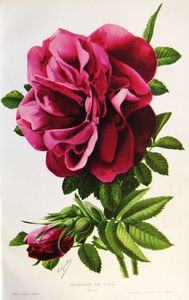It seemed I was the only customer at the David Austin Plant Centre today. Certainly, I was the only one in the gardens, striding purposefully through the mizzle, garden plan in hand.
***
A few weeks ago I came here to attend a session on rose pruning. I’d seen the picture of David Austin on the website – silver-haired, golden-faced and pensive – and I knew that if I met him, he would recognise a kindred spirit. We would talk for hours about about technical and creative aspects of rose breeding; he would value the freshness of my novice insights and would come to name his next rose after me. This was a certainty, if only he were to spot me, so I put on my prettiest coat of peacock blue velvet, to attract his eye.
I met my fellow pruners and the six of us took morning coffee and polite conversation in the oak-beamed tea rooms. A lovely lady named Diana led us to the gallery, where she described the different types of roses and explained how each should be shaped and trained. After questions, it was to the gardens for practical.
As we filed out into the January sleet, Diana looked critically at my coat and offered me her spare wax jacket, which I declined. She led us around the gardens, pointing out the differences in form between shrub roses and hybrid teas (one natural and voluptuous; the other upright and overbred), and in habit between climbers and ramblers (climbers generally have stiff growth and flower continuously; ramblers tend to be more lax but vigorous in growth, with one big burst of flower often followed by hips).
We stopped to admire a particularly handsome rambler, rosa mulliganii, its clusters of deep coral-bead hips dripping from a pale stone wall: ‘Mr Austin says the best way to grow a rambler on a wall is to plant it behind, so that it cascades over,’ Diana told us, and we all nodded.
We were still admiring and nodding when I felt the thud of two muddy paws on my thigh; the jowly face of a stout black labrador smiled up at me. I don’t do animals, and this seems to make me a target for them, but while I know that cats are sent from the devil purely to antagonise me, I am prepared to believe that dogs have more benign intentions, evangelical even; they see me as unconverted, convincible.
With outward acquiescence, I said ‘hello doggie,’ then, with my eyes: ‘my soul is as stone to you and you shall not have it’.
‘Hello Betty’, said Diana, then looking over to a white-haired old gentleman on the gravel path beyond, she said ‘good morning Mr Austin.’
David Austin nodded at Diana and tapped his walking stick at Betty, who gave up on me happily to returned to his heel.
I knew I would never wash that coat again.
***
I passed from the Long Garden into the Renaissance Garden and, still studying the plan closely, walked beside the water channel towards the Pergolas.
‘Won’t do you much good at this time of year.’
I looked across the water to see that same white-haired old gentleman looking back at me, and I realised how ridiculous I must appear to him, using a plan to try to distinguish one set of bare twigs from another. Betty spotted me and bounded over.
‘I’m looking for hips,’ I explained to Mr Austin, as I patted Betty.
He nodded, and moved to tap his stick.
‘I was thinking Francis E Lester,’ I said quickly, ‘planted behind a fence, so that it cascades over.’
‘Best way,’ he said. ‘How high, the fence?’ He drew the tip of his walking stick up in a vertical line.
‘About there,’ I said when his stick-rule reached nearly six foot.
‘Yes, that will do,’ he nodded, and tapped his stick. He continued his walk, with Betty at his heel.
I glided through the Lion Garden and on into the shop, where I bought Francis E Lester and the biggest book on roses I could find.
***
A treat for those with misspent 1980s:

